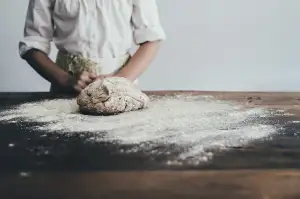Perfectly Flipped: Mastering the Art of Making Over Easy Eggs - Step-by-Step Recipe

Over easy eggs are a classic breakfast dish that never fails to satisfy. With their perfectly cooked whites and runny yolks, they are a delicious treat that can be enjoyed any time of the day. The name "over easy" refers to the cooking technique of flipping the eggs once they are cooked on one side, resulting in a lightly cooked yolk while still maintaining a soft and tender texture. This method requires some practice and finesse, but with our step-by-step recipe, you'll soon become a master at making over easy eggs. So grab your spatula and let's get cracking!
Step 1: Preparing the Pan and Heat
To achieve perfectly flipped over easy eggs, it is crucial to start with a well-prepared pan and the right heat. Begin by selecting a non-stick skillet or frying pan. The non-stick surface will prevent the eggs from sticking and make flipping them easier.
Next, place the pan on the stove over medium-low heat. It's important not to use high heat as it can cause the eggs to cook too quickly and become rubbery. Preheating the pan allows for even cooking and prevents any hot spots that could result in unevenly cooked eggs.
While the pan is heating up, you can add a small pat of butter or drizzle some olive oil onto the surface. This will provide a delicious flavor to your eggs and help prevent them from sticking.
Allow the butter to melt completely or let the oil heat up before moving on to cracking the eggs. Taking these steps to prepare your pan and heat properly sets you up for success in creating beautifully flipped over easy eggs.
Step 2: Crack the Eggs
Once your pan is heated and ready, it's time to crack the eggs. Take each egg one at a time and gently tap it against the edge of the pan. Make sure to crack it evenly so that the yolk remains intact.
Next, hold the cracked egg over the pan and carefully open it, allowing the contents to slide into the hot surface. Be cautious not to drop any shell fragments into the pan.
Repeat this process for each egg you wish to cook. It's important to crack them individually rather than cracking them all into a separate bowl. This way, you can ensure that each egg cooks evenly and doesn't stick together.
Remember, cracking eggs requires a delicate touch. Practice makes perfect, so don't worry if you don't get it right on your first try. With time, you'll become more proficient in cracking eggs flawlessly for your over easy masterpiece.
Step 3: Cooking the Eggs on One Side
Now that your pan is hot and ready, it's time to crack the eggs. Gently tap the eggshell against the edge of the pan, making sure not to break the yolk. With a swift motion, open the shell and let the egg slide into the pan.
Allow the eggs to cook undisturbed for about 2 minutes on medium heat. This will give them enough time to set and develop a golden crust on one side. Keep an eye on them to prevent any burning or sticking.
During this cooking process, you may notice that the edges of the eggs start to turn slightly opaque while the center remains runny. This is perfectly normal and what we're aiming for in over easy eggs.
If you prefer your yolks more cooked, you can cover the pan with a lid for an additional minute or two. However, be careful not to overcook them as this will result in hard yolks instead of runny ones.
Remember, patience is key when cooking over easy eggs. Resist the temptation to flip them too early or move them around in the pan. Let them cook undisturbed until they are ready for their grand flip!
Step 4: Flipping the Eggs
Now comes the moment of truth - it's time to flip those eggs! The key to a successful flip is confidence and a steady hand. Gently slide a spatula underneath each egg, making sure to get as close to the bottom of the pan as possible. With a quick flick of the wrist, swiftly turn the eggs over in one smooth motion.
Be careful not to apply too much force or you risk breaking the delicate yolks. Practice makes perfect, so don't be discouraged if your first few attempts aren't flawless. Remember, it's all part of mastering the art of making over easy eggs.
Once flipped, let the eggs cook for another 30 seconds to a minute on this side. This will ensure that both sides are evenly cooked and that the yolk remains delightfully runny.
If you prefer your yolks more well-done, simply cook them for an additional minute or two on this side. However, be cautious not to overcook them as they may lose their desired creamy texture.
Flipping over easy eggs can be challenging at first, but with practice and patience, you'll soon become a pro. So don't give up - keep flipping until you achieve that perfect golden brown exterior and oozy yolk that makes these eggs so irresistible.
In the next step, we'll explore how to finish cooking the eggs on the other side while preserving their delicate nature.
Step 5: Cooking the Eggs on the Other Side
Now that you have successfully flipped your eggs, it's time to cook them on the other side. Gently slide the spatula under the eggs and carefully flip them over. The yolk should still be runny, but if you prefer a firmer yolk, let it cook for an additional 30 seconds.
Continue cooking the eggs on this side for about 1 minute or until the whites are fully set. Be sure to adjust the heat if necessary to prevent burning. You want a nice golden color on both sides of the eggs.
Remember, timing is crucial here. Overcooking will result in a hard yolk, while undercooking may leave you with raw egg whites. Practice makes perfect, so keep experimenting until you find your desired level of doneness.
Once cooked to perfection, carefully transfer the over easy eggs onto a plate using a spatula. They are now ready to be seasoned and served alongside your favorite breakfast accompaniments.
In the next step, we will explore different seasoning options and variations to elevate your over easy eggs to new heights of deliciousness. Stay tuned!
Step 6: Seasoning and Serving
Once the eggs are cooked to perfection, it's time to add some flavor and serve them up. Start by sprinkling a pinch of salt and pepper over the eggs to enhance their taste. If you like a bit of heat, you can also add a dash of hot sauce or sprinkle some chili flakes.
To make your over easy eggs even more delicious, consider adding some toppings or accompaniments. A sprinkle of fresh herbs like chives or parsley can add a burst of freshness. You can also melt some cheese on top for an extra creamy and indulgent touch.
When it comes to serving, there are endless possibilities. Over easy eggs pair well with toast, English muffins, or bagels. You can also serve them alongside crispy bacon or sausages for a hearty breakfast. For a lighter option, serve the eggs on a bed of greens with a drizzle of vinaigrette.
Remember that timing is crucial when serving over easy eggs. They are best enjoyed immediately while the yolk is still runny and warm. So be sure to have your plates ready and call everyone to the table as soon as the eggs are done cooking.
With these simple steps and creative serving ideas, you'll be able to master the art of making over easy eggs in no time. So go ahead, give it a try, and enjoy this classic breakfast dish that never fails to satisfy!
Tips and Variations for Over Easy Eggs
1. Use a non-stick pan: This will make it easier to flip the eggs without them sticking to the pan.
2. Adjust the heat: Cooking over easy eggs requires a delicate balance of heat. Start with medium-high heat, but adjust as needed to prevent burning or undercooking.
3. Perfect timing: Timing is crucial when cooking over easy eggs. Cook the first side for about 2 minutes until the whites are set but the yolk is still runny. Flip carefully and cook for another 30 seconds to 1 minute on the other side.
4. Experiment with seasonings: While salt and pepper are classic choices, feel free to get creative with your seasonings. Try adding herbs like chives, basil, or dill, or sprinkle some grated cheese on top for extra flavor.
5. Add toppings: Over easy eggs can be served plain or with various toppings. Consider adding sautéed vegetables, bacon bits, avocado slices, or even salsa to elevate the taste and texture of your dish.
6. Serve with toast: Over easy eggs pair perfectly with toast as it provides a delicious vehicle for soaking up the runny yolk. Choose your favorite type of bread and toast it to perfection before serving alongside your eggs.
7. Customize your cooking method: If you prefer your yolks slightly more cooked, try making sunny-side-up eggs instead of over easy. Alternatively, if you like them completely cooked through, opt for over medium or over hard eggs.
By following these tips and experimenting with different variations, you'll soon become a master at making perfectly flipped over easy eggs every time!
In conclusion, mastering the art of making over easy eggs is a skill that will elevate your breakfast game. With just a few simple steps, you can create perfectly flipped eggs that are deliciously runny on the inside and beautifully golden on the outside. Remember to prepare your pan and heat it properly, crack the eggs gently, cook them on one side until the whites are set but the yolk is still runny, flip them carefully, and cook for a short time on the other side. Season with salt and pepper to taste and serve alongside your favorite breakfast accompaniments. Don't be afraid to get creative with toppings or add-ins to customize your over easy eggs. So go ahead and give it a try - soon you'll be flipping eggs like a pro!
Published: 17. 12. 2023
Category: Recipes



